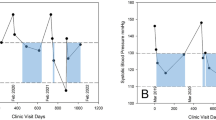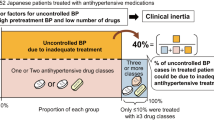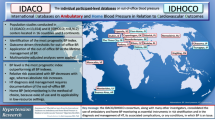Abstract
Hypertension is the most common modifiable risk factor for cardiovascular disease and death, and lowering blood pressure with anti-hypertensive drugs reduces target organ damage and prevents cardiovascular disease outcomes. The recent trials SPRINT and HOPE-3 will lead to changes in the way we manage hypertension and impact on clinical practice guidelines. These studies also demonstrate the shift toward automated blood pressure measurements. We have reviewed these studies and others to put them in context with the guidelines that have come before and to describe how they will impact on hypertension treatment thresholds and targets, the treatment of hypertension in the elderly, and changing approaches to the management of hypertension including resistant hypertension.
This is a preview of subscription content, access via your institution
Access options
Subscribe to this journal
Receive 12 digital issues and online access to articles
$119.00 per year
only $9.92 per issue
Buy this article
- Purchase on Springer Link
- Instant access to full article PDF
Prices may be subject to local taxes which are calculated during checkout
Similar content being viewed by others
References
Lim SS, Vos T, Flaxman AD, Danaei G, Shibuya K, Adair-Rohani H et al. A comparative risk assessment of burden of disease and injury attributable to 67 risk factors and risk factor clusters in 21 regions, 1990–2010: a systematic analysis for the Global Burden of Disease Study 2010. Lancet 2012; 380 (9859): 2224–2260.
Chow CK, Teo KK, Rangarajan S, Islam S, Gupta R, Avezum A et al. Prevalence, awareness, treatment, and control of hypertension in rural and urban communities in high-, middle-, and low-income countries. JAMA 2013; 310 (9): 959–968.
Benjamin EJ, Blaha MJ, Chiuve SE, Cushman M, Das SR, Deo R et al. Heart disease and stroke statistics—2017 update: a report from the American Heart Association. Circulation 2017; 135 (10): e646.
Padwal RS, Bienek A, McAlister FA, Campbell NRC . Outcomes research task force of the Canadian hypertension education P. epidemiology of hypertension in Canada: an update. Can J Cardiol 2015; 32 (5): 687–694.
Campbell NR, Brant R, Johansen H, Walker RL, Wielgosz A, Onysko J et al. Increases in antihypertensive prescriptions and reductions in cardiovascular events in Canada. Hypertension 2009; 53 (2): 128–134.
Dionne JM, Harris KC, Benoit G, Feber J, Poirier L, Cloutier L et al. Hypertension Canada’s 2017 guidelines for the diagnosis, assessment, prevention and treatment of pediatric hypertension. Can J Cardiol 2017; 33 (5): 577–585.
Ambrosius WT, Sink KM, Foy CG, Berlowitz DR, Cheung AK, Cushman WC et al. The design and rationale of a multicenter clinical trial comparing two strategies for control of systolic blood pressure: the Systolic Blood Pressure Intervention Trial (SPRINT). Clin Trials 2014; 11 (5): 532–546.
Group SR . A randomized trial of intensive versus standard blood-pressure control. N Engl J Med 2015; 2015 (373): 2103–2116.
Williamson JD, Supiano MA, Applegate WB, Berlowitz DR, Campbell RC, Chertow GM et al. Intensive vs standard blood pressure control and cardiovascular disease outcomes in adults aged⩾75 years: a randomized clinical trial. JAMA 2016; 315 (24): 2673–2682.
Parati G, Ochoa JE, Bilo G, Zanchetti A . SPRINT blood pressure. Am Heart Assoc 2017; 69 (1): 15–19.
Drawz PE, Pajewski NM, Bates JT, Bello NA, Cushman WC, Dwyer JP et al. Effect of intensive versus standard clinic-based hypertension management on ambulatory blood pressurenovelty and significance. Hypertension 2017; 69 (1): 42–50.
Lonn EM, Bosch J, Lopez-Jaramillo P, Zhu J, Liu L, Pais P et al. Blood-pressure lowering in intermediate-risk persons without cardiovascular disease. N Engl J Med 2016; 374 (21): 2009–2020.
Yusuf S, Bosch J, Dagenais G, Zhu J, Xavier D, Liu L et al. Cholesterol lowering in intermediate-risk persons without cardiovascular disease. N Engl J Med 2016; 374 (21): 2021–2031.
Yusuf S, Lonn E, Pais P, Bosch J, Lopez-Jaramillo P, Zhu J et al. Blood-pressure and cholesterol lowering in persons without cardiovascular disease. N Engl J Med 2016; 374 (21): 2032–2043.
Chobanian AV, Bakris GL, Black HR, Cushman WC, Green LA, Izzo JL Jr. et al. The seventh report of the joint national committee on prevention, detection, evaluation, and treatment of high blood pressure: the JNC 7 report. JAMA 2003; 289 (19): 2560–2572.
James PA, Oparil S, Carter BL, Cushman WC, Dennison-Himmelfarb C, Handler J et al. 2014 evidence-based guideline for the management of high blood pressure in adults: report from the panel members appointed to the Eighth Joint National Committee (JNC 8). JAMA 2014; 311 (5): 507–520.
Mancia G, Fagard R, Narkiewicz K, Redon J, Zanchetti A, Bohm M et al. 2013 ESH/ESC guidelines for the management of arterial hypertension: the Task Force for the Management of Arterial Hypertension of the European Society of Hypertension (ESH) and of the European Society of Cardiology (ESC). Eur Heart J 2013; 34 (28): 2159–2219.
Mancia G, De Backer G, Dominiczak A, Cifkova R, Fagard R, Germano G et al. 2007 guidelines for the management of arterial hypertension: the task force for the management of arterial hypertension of the European Society of Hypertension (ESH) and of the European Society of Cardiology (ESC). J Hypertens 2007; 25 (6): 1105–1187.
Mancia G, Fagard R, Narkiewicz K, Redon J, Zanchetti A, Bîhm M et al. 2013 ESH/ESC guidelines for the management of arterial hypertension: the Task Force for the Management of Arterial Hypertension of the European Society of Hypertension (ESH) and of the European Society of Cardiology (ESC). Blood Press 2013; 22 (4): 193–278.
Daskalopoulou SS, Rabi DM, Zarnke KB, Dasgupta K, Nerenberg K, Cloutier L et al. The 2015 Canadian Hypertension Education Program recommendations for blood pressure measurement, diagnosis, assessment of risk, prevention, and treatment of hypertension. Can J Cardiol 2015; 31 (5): 549–568.
Myers MG . Automated office blood pressure—incorporating SPRINT into clinical practice. Am J Hypertens 2017; 30 (1): 8–11.
Leung AA, Nerenberg K, Daskalopoulou SS, McBrien K, Zarnke KB, Dasgupta K et al. Hypertension Canada's 2016 Canadian hypertension education program guidelines for blood pressure measurement, diagnosis, assessment of risk, prevention, and treatment of hypertension. Can J Cardiol 2016; 32 (5): 569–588.
Xie X, Atkins E, Lv J, Rodgers A . Intensive blood pressure lowering – Authors' reply. The Lancet 2016; 387 (10035): 2291.
Ettehad D, Emdin CA, Kiran A, Anderson SG, Callender T, Emberson J et al. Blood pressure lowering for prevention of cardiovascular disease and death: a systematic review and meta-analysis. The Lancet 2016; 387 (10022): 957–967.
Law MR, Wald NJ . Risk factor thresholds: their existence under scrutiny. BMJ 2002; 324 (7353): 1570–1576.
SPS3 Study Group SPS3 Study Group, Benavente OR SPS3 Study Group, Coffey CS SPS3 Study Group, Conwit R SPS3 Study Group, Hart RG SPS3 Study Group, McClure LA et al. Blood-pressure targets in patients with recent lacunar stroke: the SPS3 randomised trial. The Lancet 2013; 382 (9891): 507.
Accord Study Group. Effects of intensive blood-pressure control in type 2 diabetes mellitus. N Engl J Med 2010; 2010 (362): 1575–1585.
Progress Collaborative Group. Randomised trial of a perindopril-based blood-pressure-lowering regimen among 6105 individuals with previous stroke or transient ischaemic attack. [see comments.] [erratum appears in Lancet 2001; 358(9292): 1556.] Lancet 2001; 358 (9287): 1033–1041.
Borhani NO, Applegate WB, Cutler JA, Davis BR, Furberg CD, Lakatos E et al. Systolic Hypertension in the Elderly Program (SHEP). Part 1: rationale and design. Hypertension 1991; 17 (Suppl 3): II2–15.
Staessen JA, Fagard R, Thijs L, Celis H, Arabidze GG, Birkenhager WH et al. Randomised double-blind comparison of placebo and active treatment for older patients with isolated systolic hypertension. The Systolic Hypertension in Europe (Syst-Eur) Trial Investigators [see comments]. Lancet 1997; 350 (9080): 757–764.
Beckett NS, Peters R, Fletcher AE, Staessen JA, Liu L, Dumitrascu D et al. Treatment of hypertension in patients 80 years of age or older. N Engl J Med 2008; 358 (18): 1887–1898.
Chow CK, Thakkar J, Bennett A, Hillis G, Burke M, Usherwood T et al. Quarter-dose quadruple combination therapy for initial treatment of hypertension: placebo-controlled, crossover, randomised trial and systematic review. The Lancet 389 (10073): 1035–1042.
Siddiqui M, Dudenbostel T, Calhoun DA . Resistant and refractory hypertension: antihypertensive treatment resistance vs treatment failure. Can J Cardiol 2016; 32 (5): 603–606.
Williams B, MacDonald TM, Morant S, Webb DJ, Sever P, McInnes G et al. Spironolactone versus placebo, bisoprolol, and doxazosin to determine the optimal treatment for drug-resistant hypertension (PATHWAY-2): a randomised, double-blind, crossover trial. The Lancet 2015; 386 (10008): 2059–2068.
Maar MA, Yeates K, Perkins N, Boesch L, Hua-Stewart D, Liu P et al. A Framework for the Study of Complex mHealth Interventions in Diverse Cultural Settings. JMIR Mhealth Uhealth 2017; 5 (4): e47.
Bangalore S, Toklu B, Gianos E, Schwartzbard A, Weintraub H, Ogedegbe G et al. Optimal systolic blood pressure target after SPRINT: insights from a network meta-analysis of randomized trials. Am J Med 2017; 130 (6): 707–719 e8.
Parati G, Torlasco C, Omboni S, Pellegrini D . Smartphone Applications for Hypertension Management: a Potential Game-Changer That Needs More Control. Curr Hypertens Rep 2017; 19 (6): 48.
Author information
Authors and Affiliations
Corresponding author
Ethics declarations
Competing interests
Dr Tobe has been funded by the Northern Ontario School of Medicine as a Research Chair and has received compensation as the Canadian primary investigator for two multinational research studies in diabetic nephropathy (Bayer and AbbVie). The remaining authors declare no conflict of interest.
Rights and permissions
About this article
Cite this article
Gudsoorkar, P., Tobe, S. Changing concepts in hypertension management. J Hum Hypertens 31, 763–767 (2017). https://doi.org/10.1038/jhh.2017.57
Received:
Revised:
Accepted:
Published:
Issue Date:
DOI: https://doi.org/10.1038/jhh.2017.57



